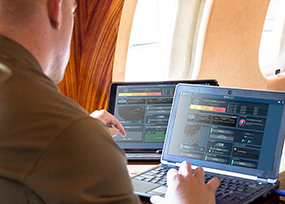In 2019, a cross-functional team of Gulfstream employees met over a six-week period to create a list of helpful hints that, when followed, should improve the inflight streaming experiences of passengers flying on Gulfstream aircraft. This comprehensive list, comprised of 10 tips, can be applied to other OEM aircraft as well.
- Understand your aircraft’s service plan and its level of service
For Gulfstream operators, streaming is supported with Jet ConneX service plan (minimum of JX 40GB) and the AVANCE L5 streaming plan. - Know how to use your service provider’s troubleshooting app (SD Cabin, Gogo DASH)
Apps can identify if there is a signal, how strong the signal is, and whether there is a device that is using large amounts of data. This information can be helpful when troubleshooting streaming issues. Identifying “Top Talkers” or devices that are consuming large amounts of bandwidth can assist in bandwidth management of non-streaming devices. - Look at what is streaming
Live feeds, including sports, require more bandwidth than video on demand such as Netflix. - Consider where you are flying
Air-to-Ground (ATG) streaming is not supported outside of the CONUS coverage map. Because an ATG system requires a ground station to send the signal, streaming can be interrupted as the plane flies beyond a coastline and over the ocean. Almost all streaming services require location services to be enabled on the streaming device. This is due to regional and country content restrictions. Apple devices use their built in GPS to acquire their location for example, and no streaming services will work outside of Conus. Other devices such as Roku acquire their location via IP address, thus, for an SD customer, allowing streaming outside of Conus. ATG and SwiftBroadBand will slow in congested air traffic areas. Streaming will not work on SwiftBroadBand. - Stored or streaming media? When possible, choose stored media over streaming as stored media does not use data.
- Know the bandwidth requirements of the media apps you are using
Not all apps are created equal – some apps use more data than others. Most apps use adaptive bitrate streaming so not all streaming requirements are hard set requirements. Various network properties will contribute to the stream quality. Certain apps work better than others even while watching the same programming. Ensure the streaming devices are correctly configured for optimal streaming. All devices such as Apple TV, Roku, Firestick, etc. have settings that need to be optimized for best performance. - Turn your cell phones to Low Power (iPhone) or Battery Saver (Android) mode
In these modes, you stay on the network, but don’t continually refresh. It is also important for non-passenger devices to use Low Data Mode on iOS devices. - Once a quarter, update all onboard streaming devices, including Apple TV
Remove devices from the plane and update via a ground-based Wi-Fi source or Ethernet (no need to incur data charges on your aircraft). Check with your service provider to see if filter protocols are enabled. This can block certain types of data transmissions. - Limit the number of connected devices
Disconnect some of the devices to see if streaming improves. - Streaming still an issue? Call your OEM technical operations.
Call Gulfstream Technical Operations at 1-800-810-GULF (4853) or 1-912-965-4178, and select option 2.
By Michael Wolf, Sr. Regional Sales Manager, Cabin and Connectivity
